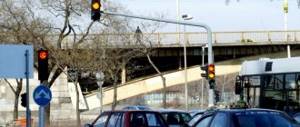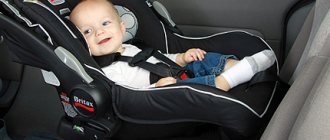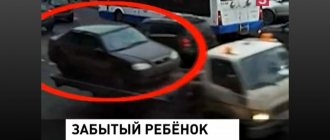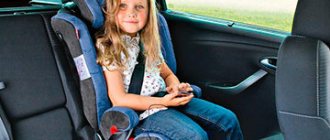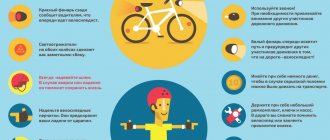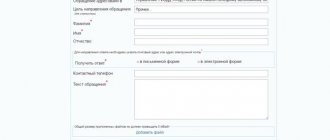At what age can you carry children in the front?
The law does not establish a minimum threshold for the age of the child. This means that a child seat can be placed in the front seat from birth. But you need to take into account that the car seat itself must be age appropriate.
As for the upper limit, it is 12 years. After this age, the driver can safely use standard seat belts for the child.
| Car seats for the front seat |
| Group 0+ (from 0 to 13 kg) |
| Britax Romer Baby Safe Plus |
| Group 0+/1 (from 0 to 18 kg) |
| Peg-Perego Viaggio 0+/1 Switchable |
| Group 1 (from 9 to 18 kg) |
| Britax Romer King ii |
| Group 0/1/2 (from 0 to 25 kg) |
| Joie Stages |
| Group ½ (from 9 to 25 kg) |
| Mishutka lb 718 |
| Group 1/2/3 (from 9 to 36 kg) |
| Britax Romer Evolva 1 2 3 |
| Group ⅔ (from 15 to 36 kg) |
| Britax Romer Kid ii |
Rules for using restraint devices
Rules for using child seats and adapters:
- Restrained children should not be left unattended in the vehicle.
- For children under 16 years old, it is better to choose the back seat of the car, it is safer.
- Adults should regularly check that their seat belt is fastened.
- There should be no gaps in the back of the car seat.
- Center seat belts should only be used to secure a car seat or in conjunction with a child restraint belt.
- You cannot use child seats that have already been in a traffic accident.
- You should choose a child seat based on the height and weight of the child. The buckle and adapters must be in working order.
- The top strap should not be overtightened; it should be below the hip or level.
- The booster should only be used by children over 7 years of age.
- FEST boosters and adapters are prohibited from being used to fasten passengers in the front seats.
Innovations in traffic rules from 2021
In the summer of 2021, namely on July 12, adjustments were made to the traffic rules. They, in particular, touched on how to transport a child in the front seat.
The differences between the new version of the traffic rules and the previous one are as follows:
- The concept of “other devices” is excluded. This means that from 2021, you can only use a car seat in both the back and front seats, and not any straps or fasteners. It has been experimentally established that only front and rear car seats can reduce the risks of negative consequences in accidents. And the car’s standard seat belts do a better job of safety than “other devices.”
- For this reason, from 2021 it is legal to transport children from seven years old to twelve years old in the rear seat using standard seat belts. The choice of parents should be justified by the physiological characteristics of the children.
How to secure a car seat in a car with belts?
For the safety of your baby, it is necessary not only to make the right choice of device, determine the location of its attachment, but also to correctly secure the car seat with belts. An incorrectly installed seat will not save you in an accident, but will cause significant injury. Take this moment very seriously.
It is also important to secure the seat correctly - otherwise injuries cannot be avoided.
The following methods can be used to install a car seat:
- Stationary car seat belts
- Isofix system
- Latch or SuperLatch system
Every car is equipped with a stationary standard three-point belt; it is a universal and inexpensive tool. With it, the chair can be installed without problems on any of the seats. However, its installation is quite complicated, and if the chair is equipped with a table, then there may simply not be enough belt. And the security of such a mount is not very high.
When using this method, it is important to remember the following:
- Car seat belts do not guarantee rigid fixation of the car seat for a child, but still it should not wobble, play is acceptable within 2 cm.
- It is necessary to adjust the belt tension after the small passenger is seated in the seat. The fabric cannot be twisted, sagging, or fit too tightly. The best gap between the belt and the child's body is about 3-4 cm - 2 fingers.
- Install a fastener on the belts so that they do not stretch or slip while driving.
- The tape should go through all the guides and be located at the level of the child’s shoulders and hips. Under no circumstances should the belt be at the level of his neck.
In the rear seat
Installing a car seat in the rear seat is as follows:
- Place the car seat on the seat. According to the instructions for the car seat, guide the belt strap through the special holes.
- Tighten the belt and lock the buckle.
- Press down on the chair and make sure it is well secured and there is no excessive play.
- Release the seat of the chair from the belt tape, place the baby in it, and fasten the belts.
- Keeping an eye on the pads, secure the locks.
Advantages of front transport
The placement of a child seat in the front seat has its positive aspects:
- The driver can always have easy and free access to the child. This is especially important if a newborn baby or a toddler who is not yet able to care for himself is riding in the front of the car. So, for example, if there is a child seat in the front seat, you can give the child a bottle or rattle in his hands without being distracted from driving and without stopping on the side of the road.
- When mom or dad (another adult) are nearby in close proximity to the baby, he feels much more comfortable. It is much easier to calm a child in the front seat when he is whimsical and crying.
- Tests have proven that a baby in a car seat in the front seat is less susceptible to motion sickness. For this reason, the risk of unpleasant situations on the road is reduced by several percent. And the driver will feel calmer.
- For older children, who have already moved out of the car seat and can use a car seat in the front seat in the direction of travel of the car, it is much more interesting to look at the road, since the view becomes larger.
How to properly place a child in a car seat?
The safety of a child while driving depends not only on the correct fastening of the car seat, but also on the correct placement of the baby in the seat.
Therefore, take note of these recommendations:
- Set the back of the chair at an angle of 30-45 degrees.
- Place or place the baby in the car seat.
- The baby's legs should be straight, not bent at the knees.
- The baby should have soft cushions on both sides of his head.
- Fasten the seat belts so that they do not put pressure on his chest.
- Check the belt tension - an adult's palm should fit between the baby's back and the chair.
- You need to dress your child lightly ; warm and tight clothes can impair the effectiveness of the belts in an extreme situation. If necessary, simply cover the baby with a light blanket.
Seat your baby correctly
Are you already convinced of the importance of this purchase?
Now that you know how to properly install a car seat in a car and secure it, you can rest assured about the safety of your little one while traveling together.
Useful children's articles on the site:
- Why doesn't the child listen?
- Delayed speech development in a child
- What to do if your child constantly lies
- The child is a bully - what to do
- What can a child have with a fever?
Disadvantages of carrying in front
Despite all the comfort of placing a child in the front seat in a chair, this method also has its disadvantages:
- Thus, statistics inexorably show that the front car seat is a dangerous place for a child if the car suddenly gets into an accident. Especially when the car has airbags that deploy at the moment of a collision. The safest place in a car for a child is considered to be the one located in the back seat in the central part.
- If adults bought a car seat with an isofix fastening system for a child, then such a product is not suitable for installation on the front seat of a car due to its design features.
Isofix mounting system: how to secure a child seat?
One of the best systems that allows you to properly secure a child car seat is the isofix system. This is an international certified system accepted throughout the world.
Fastening
The main advantages of isofix are the following:
- Most modern cars are equipped with it
- Easy to install and secured with special connectors.
- It is very difficult to install incorrectly.
- Features a very high level of protection.
- The car seat is secured very firmly , it does not wobble, regardless of whether there is a child there or not.
Isofix mount for car seat, how to mount:
- Find metal brackets between the back and seat of the car and remove the plugs from them.
- If your chair has bracket guides, install them onto the brackets.
- The armchair brackets must be pulled out and snapped onto the brackets.
- Also remove the existing plugs and hide them together with the seat plugs.
- Now all that remains is to place the child in the chair and secure it with the internal belt.
Schematically
It must be taken into account that this system is offered as the main one, and you can attach a car seat up to 18 kg, that is, groups 0, 0+, and 1, for children up to 4 years old. When your child has crossed this threshold, isofix can only be installed as an additional system, reinforced with devices. This is an anchor belt or a telescopic stop.
Rules for transportation in the front seat
Before placing a child seat in the front seat, it is necessary to study the rules that ensure maximum safety for the child on the road. These include the following:
- If your vehicle is equipped with a front airbag, it must be disabled. In the event of a collision, the system may not be switched off and may cause further harm to a child in the front.
- Before attaching the car seat, the front seat of the car must be moved as far into the interior as possible in order to place the device comfortably and with maximum safety.
- Before driving, be sure to check your side visibility.
Important! Following these rules will help keep your child safe while driving on the road with a car seat in the front seat.
Rules for transporting children according to traffic rules
Many people remember the times when children were simply placed in the car in the arms of their parents, and occasionally they were fastened to seats with standard restraint belts. For a long time it was believed that this was more than enough. Today, legislation has tightened the requirements for the transportation of children. Now each child has his own personal car seat, which should protect him in case of an accident or other emergency situation on the road.
Basic requirements for transporting children, according to traffic rules:
- Children can be seated in the passenger compartment of a car or in the cab of a truck. It is strictly forbidden to place them in the body or trailer.
- In the front seat, a child under 12 years of age is transported in an infant carrier or car seat. Children under 7 years old can only be accommodated in the rear seat in this manner.
- The use of a booster or triangular adapter in the front seat is prohibited.
- Transporting children in the car on the laps of adults is strictly prohibited.
- Transporting children in a car without a child safety seat or infant carrier is strictly prohibited and is punishable by a fine.
Which seats are suitable for transportation in front - rating
You can install a child seat in the front seat of any type and type with some restrictions. The main thing is to respect the age and physiological characteristics of the child so that transporting the child in the front seat in a car seat is comfortable and safe for all passengers.
It is worth noting once again that products equipped with an isofix mount are not suitable for the front seats.
So, the rating looks like this.
Group 0 (from 0 to 10 kg)
This seat cannot be installed in the front seat. It's all about the design of the product.
Group 0+ (from 0 to 13 kg)
In this category there are products that can be placed in front of the vehicle in the cabin, but only against the direction of travel of the vehicle. An example is the product Britax romer baby safe plus
Britax Romer Baby Safe Plus (read review)
- serves as both a car seat and a regular baby carrier;
- fastening occurs using belts available in the car without additional devices;
- The set includes a comfortable pillow with anatomical properties;
- the internal belts of the car seat have a pleasant-to-touch layer, which is located on the reverse side;
- Additionally, the chair is equipped with a protective hood for a comfortable stay for the child;
- a baby head support system is provided, and the headrest itself can be moved across seven levels;
- The tilt of the cradle back and internal straps are also adjustable;
- To keep the car seat clean, the cover can be removed for washing;
- Enhanced safety during side collisions is provided.
Advantages
- high position in the rating based on crash test results;
- removable cover;
- durable product.
Flaws
- heavy construction;
- The material of the cover does not suit the buyers.
Compare prices in the store
Group 0+/1 (from 0 to 18 kg)
This group of car seats can be placed in the front seat both rearward and forward.
Peg-Perego Viaggio 0+/1 Switchable (read review)
- fastening with car seat belts;
- product weight 10 kg;
- additional side impact protection;
- there is an anatomical pillow;
- The internal five-point harness has soft padding.
Advantages
- chair position settings;
- comfortable;
- wide and soft seat;
- five-point seat belts.
Flaws
- not found.
The crash test result is 2 points.
Compare prices in the store
Group 1 (from 9 to 18 kg)
Car seats in this category can also be installed in the direction of travel of the car or with the child's back facing forward. One of the representatives of this group is Britax romer king ii.
Britax Romer King ii (read review)
- secured in the car using standard seat belts;
- equipped with an anatomical pillow;
- The set includes soft pads on the internal belts for the child’s comfort during the trip;
- the belts are five-point;
- the backrest can be adjusted in five positions;
- Provides side impact protection.
Advantages
- convenience;
- ease of operation;
- workmanship;
- increased security;
- large selection of colors.
Flaws
- the product itself is quite heavy;
- high price.
Compare prices in the store
Group 0/1/2 (from 0 to 25 kg)
This group of car seats contains devices for transporting children, which can only be installed facing forward in the direction of travel of the car.
Joie Stages (read review)
- fastening in the car using standard belts;
- Anatomical pillows are included;
- The internal straps have soft pads for comfort;
- the car seat has an additional pocket for things;
- thought out support for the head of a newborn;
- internal five-point belts, removable;
- the headrest is adjustable in five positions;
- seat belts are installed at five levels;
- additional side impact protection.
Advantages
- nice price;
- functionality;
- product quality.
Flaws
Not detected.
Compare prices in the store
Group ½ (from 9 to 25 kg)
Can be installed in the direction of travel. One of the representatives of this group is the Mishutka car seat lb 718.
Mishutka lb 718 (read review)
- designed for children from 9 to 25 kg;
- secured in the car with standard belts;
- installation only with the child facing forward;
- An anatomical airbag is included;
- there are soft pads on the car seat belts;
- horizontal position of the backrest is not provided;
- additional side impact protection;
- The backrest is adjustable - 3 positions.
Advantages
- increased child safety while driving;
- quality of execution;
- The backrest can be adjusted.
Flaws
- synthetic fabric is used;
- heavy product;
- takes up a lot of space in the car.
Compare prices in the store
Group 1/2/3 (from 9 to 36 kg)
Armchairs in this group can be installed. along the way. Representative – Britax Romer Evolva 1 2 3.
Britax Romer Evolva 1 2 3 (read review)
- fastening with car seat belts;
- installation in the direction of travel of the vehicle;
- no horizontal back position;
- The height of the headrest is adjustable;
- there is additional protection against side impacts;
- The cover can be removed to keep the car seat clean.
Advantages
- increased security;
- ease of use;
- reliability;
- structural strength;
- wear-resistant materials;
- versatility.
Flaws
- difficult to install in a car.
Compare prices in the store
Group ⅔ (from 15 to 36 kg)
Car seats of this type can be installed facing the child forward in the direction of travel of the vehicle. An example of such a product is Britax Romer Kid ii.
Britax Romer Kid ii (read review)
- fastening in the car using standard belts;
- forward facing installation;
- An anatomical pillow is included;
- the headrest is adjustable in 11 positions;
- protection against side impacts is provided;
- the cover is removable;
- cannot be installed on a chassis.
Advantages
- the headrest and the entire chair have additional protection against side impacts;
- complies with European safety standards;
- removable cover.
Flaws
- inconvenient fastening;
- high cost of a car seat.
Compare prices in the store
Thus, a detailed answer has been given to the question of whether it is possible to transport children in a car seat in the front seat and what are the rules, pros and cons.
How to choose a car seat for a child?
First of all, let’s determine what types of car seats there are by age:
- Group 0 – 0-10 kg, 0-6 months. The cradle is used, sideways, with your feet towards the door.
- Group 0+ – 0-13 kg, 0-1 year . Can be used as a carrier chair.
- Group 1 – 9-18 kg, 9 months-4 years. For a sitting position, in the direction of travel.
- Group 2 – 15-25 kg, 3-7 years. Installation in the direction of travel.
- Group 3 – 22-36 kg, 6-12 years. The main advantage is compactness.
3 groups and a universal option
Basic tips for choosing a car seat:
- Take into account not only the baby’s age, but also his weight and even height.
- It is best not just to take the necessary measurements of the future passenger, but to go to the store with him. There is a demo stand where you will see how comfortable the baby will be, and you will also find out on the spot whether this seat is suitable for your car.
- Try to secure the car seat, carefully check whether the belts are comfortable, whether they have fasteners, whether the fabric pads on the locks are elastic and wide, and whether the lock is locked so that the baby does not open it on his own on the way.
- A guarantee of compliance with strict European safety standards and passing all tests is the presence of the ECE R44\03 or ECE R44\04 on the belt. Without it, there is reason to doubt the safety of this car seat.
- Side protection must be installed! It protects neck, head and shoulders in case of a side impact, which, unfortunately, is not uncommon.
- Overall safety largely depends on the strength of the frame. Metal is stronger, but it is quite heavy. If you don’t want to have extra weight in your car, choose a frame made of primary processed plastic , it is much stronger.
- And, of course, do not buy a car seat for your child at dubious points of sale, but go to a company store. There, of course, it is more expensive, but much more reliable in terms of safety. And also - a huge selection, the opportunity to consult an expert, the availability of certificates and the opportunity to try out the purchase at a demo stand.
- You shouldn’t look for a used baby car seat at a cheaper price. It may have hidden defects and be sold after an accident (although by law it must be disposed of).
Pay attention to these tips
Methods for attaching a car seat for children in a car
There are several ways to secure a child seat in a car. These are the three-point belts and Isofix already mentioned above, as well as some other options described below.
We recommend: What happens if you pour sugar into the gas tank of a car?
Fastening with straps
Securing the car seat with seat belts is the simplest and most affordable option. The car seat is installed in the car interior, where the belts are threaded into special grooves and securely fix it in place. Since the design of each car seat model is individual, it should be placed in strict accordance with the instructions, because there is no single correct way to secure a child seat. But this type of fastening also has disadvantages:
- it is quite unreliable compared to other options;
- Sometimes the belts are not long enough and you have to replace them with new ones.
It is important to know: you should not lengthen the seat belts yourself if they are too short for the car seat. It is better to contact a car service center, where they will be replaced with new ones.
There are special marks on the seat design that show where the seat belt should go. If the driver is going to secure the car seat using three-point belts, you need to check when purchasing that this method of fixation is suitable for a particular model.
Red marks mean the seat is installed in the direction of travel, and blue marks mean it is positioned backwards.
If in seats for older children the child is secured using a car seat belt, then in models of categories 0, 0+ and 1, intended for infants, this function is performed by the seat’s own five-point belts. Therefore, it is important not to forget to fasten the baby with them, otherwise the chair will be of no use.
Isofix system
The principle of operation of the system is to attach the child car seat directly to the car body using special brackets, which are provided by the design of the vehicle. The hinges are located between the cushion and the seat of the car chair; you just need to connect them to the fastening elements of the structure until it clicks. According to European legislation. All cars manufactured in Europe since 2011 must be equipped with ISOFIX mounting brackets.
This method of fastening allows you to make the trip as safe as possible for the child. According to statistical studies, about 60% of car owners fasten child seats incorrectly using car seat belts. With ISOFIX the likelihood of such a development is reduced to zero.
The ISOFIX fastening locks can be easily snapped off, allowing you to quickly remove the cradle without disturbing the child.
Please note: it is not recommended to install a cradle with a child in the front seat of a car. This is the most dangerous place for a baby, because... It is the passenger sitting on the side of the driver who suffers the most in an accident.
Since the system only secures the bottom of the structure, it is necessary to additionally use an anchor strap, the hook of which is secured with a loop behind the rear seat.
Some chairs have a retractable base that rests on the floor in front of the seat, preventing it from tipping forward.
Important: after installing the seat, do not forget to hide the car’s seat belts from the baby, otherwise he may get entangled in them.
The main disadvantage of the system is that it can be used for babies weighing no more than 18 kg.
Other methods
In addition to the convenient and easy-to-use ISOFIX, there are also Latch and SuperLatch systems, which differ from it in the type of belt. These systems are popular in the USA, but are not used in Russia and Europe.
For infant carriers of category 0+, there is another equally popular option for placement in the cabin - mounting on a base. A special platform is secured in the cabin using Isofix or belts and remains inside the car all the time. And the cradle is fixed on the platform during trips.
Types of anchorages on child car seats
Children's car seats differ from each other in many ways, including fastening methods. This point should be taken into account when choosing such a device.
Universal mounts
A universal child car seat in a car of almost any model is secured using standard seat belts. Most seat models are equipped with their own set of belts, but they are intended for small children. In models that are designed for older users, as well as in boosters, such elements are absent. When choosing a universal seat, it is necessary to check the length of the seat belts so that it is convenient to install it and fasten the child.
Such universal chairs are extremely convenient if a family uses several cars or owns a vehicle from a Russian manufacturer. For example, the vast majority of Lada models do not have any fastening devices. Moreover, there are even cars in which there are no seat belts in the back seat. Although there are seats for such purposes, there is no choice where to install the child car seat.
If you are the owner of just such a car, then installing a child seat yourself is prohibited, since such actions are regarded as serious interference. For this service, you must contact a car service center. In addition, it is prohibited to change the length of the belts by adding additional belts. In the event of an accident, even the strongest seams can come apart from the heavy load and weight that will put pressure on them.
We recommend: Is it possible to ride on Velcro in the summer?
The use of universal seats is also justified if taxis are used frequently. It is rare to find vehicles that are suitably adapted for transporting small passengers.
Now let’s take a closer look at how to properly fasten a child car seat using seat belts:
- we increase the length of the belt to about a meter by pulling it out to facilitate further steps;
- install the seat in the appropriate place in the car;
- tighten the belt to the maximum possible limit;
- we check the stability of the structure, which should not move freely;
- periodically you will need to tighten the standard tape, which often slides out when the car is moving;
- the restraint device can be additionally equipped with a special clip, which is intended for a seat belt;
- Pay attention to the side of the chair, if you have a certified product in your hands, you will see color guides and schematic tips that make all processes easier.
IsoFix fastenings
In 1987, as a result of joint work between the manufacturer of car seats for children Romer and the Volkswagen concern, a new type of fastening was proposed, which differed from its predecessors in its simplicity and higher reliability. Over time, this type of fastening was recognized as a standard by almost all modern automobile manufacturers. Europe even passed a law obliging all automakers to equip their models with a similar mount.
The IsoFix design includes two steel hinges, which are shaped like the letter P. They are located at a distance of 28 cm from each other. These elements are attached to the load-bearing frame of the vehicle under the back of the rear seat. Hinges and fixing elements have a set of parameters and characteristics that are strictly regulated by European legislation.
Now let's figure out how to install a child seat using this type of fastening. Here you need to follow this principle:
- we determine the location of the brackets that are located on the fasteners;
- we move the two lower brackets towards them along the guides (they are located in the rear of the car seat);
- Using special “tongues” we grab the staples.
If everything was done correctly, you will hear a click, which will indicate that the staple has been captured. To unfasten the seat, you will need to unlock the locks, after which you can move the seat away.
Many modern cars are equipped with additional brackets, due to which the seat is secured not at two, but at three points. For this third point, in most cases an “anchor” belt is used. Its design resembles an arc that has a hook at the top of the chair. This arc has a regulation system that changes its length. The hook attaches to a bracket that can be located behind the back of a car seat, in the trunk on the floor, or on the ceiling. Due to the presence of such an additional belt, the load that falls on the main fastening is reduced, and the force of the whiplash that occurs during sudden braking is also reduced.
A special floor-thrust mechanism, which is intended for seats located opposite the direction of movement of the car, has approximately the same function. The efficiency of such a mechanism is not as high as in an anchor belt, and the design is larger, but you can do without additional brackets.
No matter how reliable the fastening we are considering is, if the child weighs more than 15 kg, it is necessary to additionally fasten them with car seat belts. Seats in which IsoFix type anchorages are installed can be used without seat belts only if they belong to groups 0 to 1. If the child belongs to group 2 or 3, IsoFix anchorages are used as additional restraints. the chair is in place and well secured. In this case, the child must be fastened with a standard car seat belt. Some car seat models combine IsoFix technology with universal fasteners.
Installing a car seat
See also
Spikes or Velcro, which is better in winter: reviews, tests, comparison
The installation of a child seat and its fixation in it directly depends on the installation system used, as well as the type of car seat design.
Universal models have settings that adapt the product to a child with different weight, height, etc. This allows you to change the configuration as they grow older. If the child has grown up and no longer fits the limitations of the product, it needs to be changed. Not a child, of course. And the chair.
If you use regular belts, installation is performed according to the following algorithm:
see also
What is the trunk volume of different versions of Lada Vesta
- move the front seat so that it is not in the way;
- place the car seat in the selected area;
- pull the belt through the grooves in the structure;
- check stability;
- seat the child;
- secure the internal straps;
- Make sure that nothing is pressing, pinching or interfering anywhere.
In the case of Isofix, everything is even simpler. The chair is simply connected to the locks and latched.


